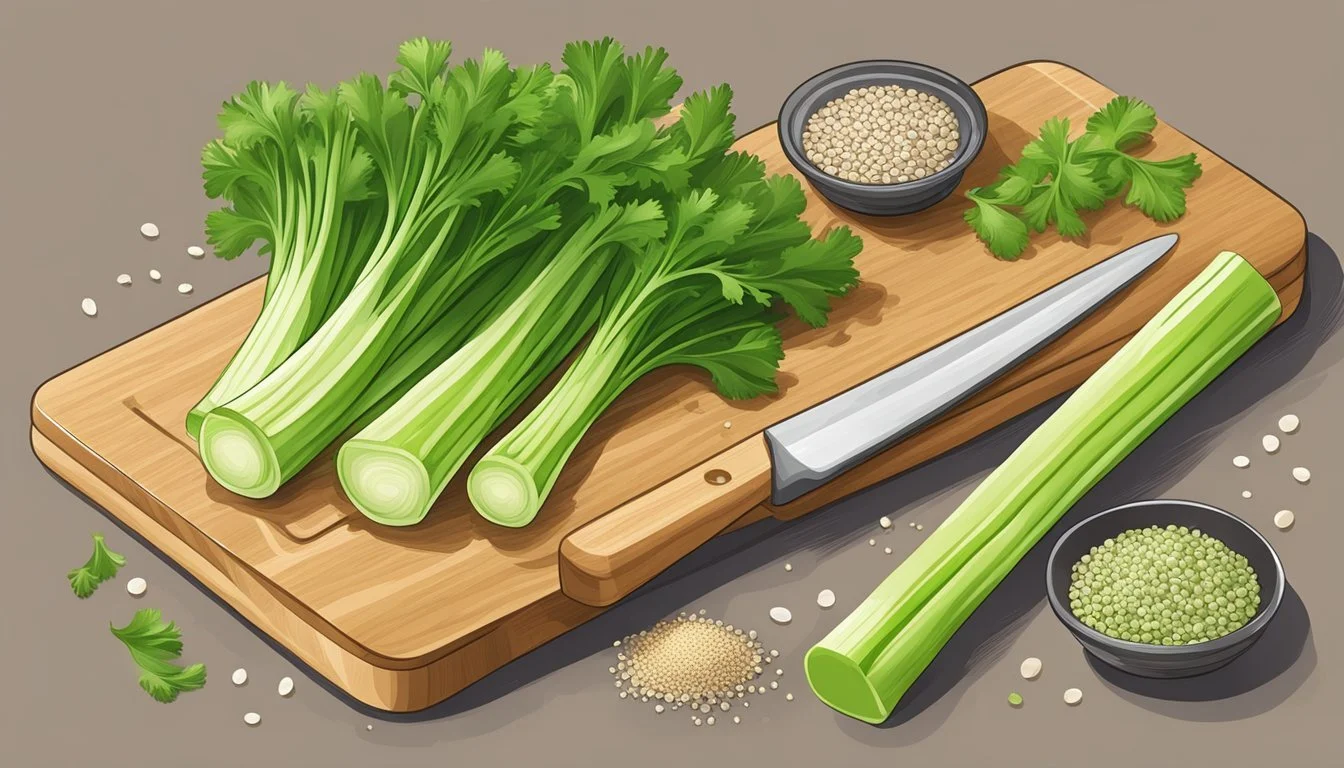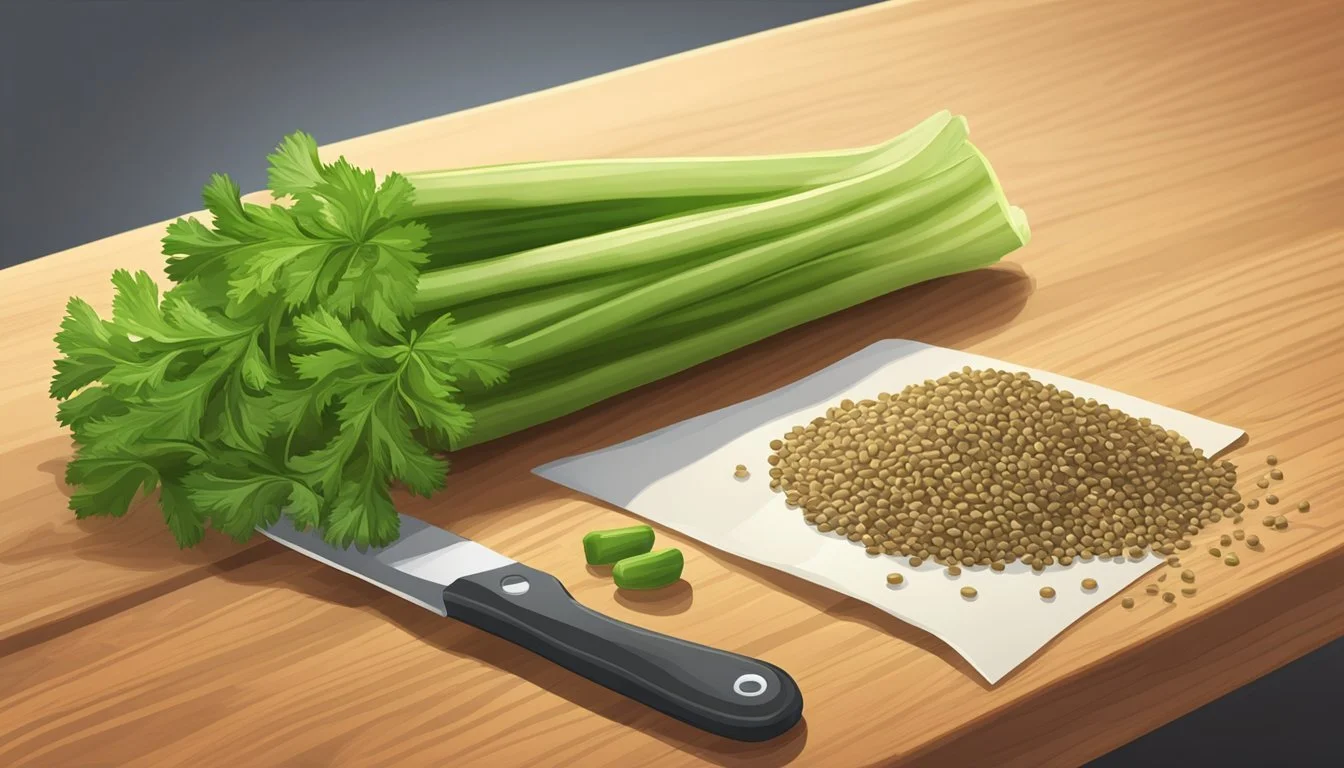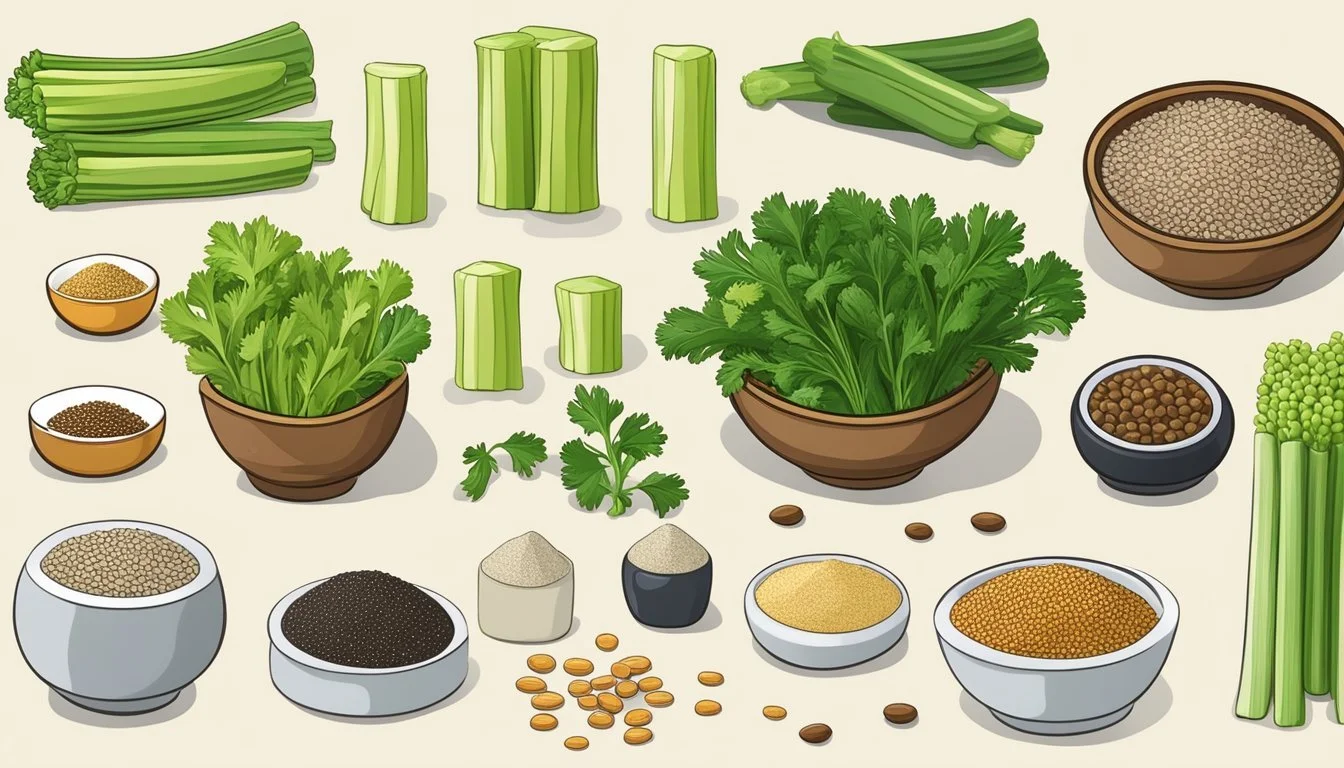Celery, Celery Salt, Celery Seed Substitutes
Your Guide to Alternative Ingredients
Celery, in its various forms, plays an essential role in culinary arts, imparting distinct flavors to an array of dishes. Celery seeds, derived from wild celery, have a vegetal, herbal taste that serves as a foundational undertone for a variety of recipes. They enhance the flavor profiles of potato salad, soups, stews, and seafood dishes. Celery salt, a derivative that combines ground celery seeds with salt, is similarly crucial for adding a savory note to dishes. It is often used to season meats, to garnish cocktails like Bloody Marys, and to elevate the taste of simpler snacks like popcorn and French fries.
Despite their importance in cooking, there are occasions when cooks may find themselves short of these ingredients or when individuals with dietary restrictions require alternatives. Substitutes must be able to mimic the unique taste of celery seed and the salty, savory flavor profile of celery salt. Among the substitute options, celery salt can often be replaced by mixing plain salt with a substitute for celery seed; this helps to retain both the celery flavor and the saltiness in dishes.
When considering alternatives, it's important to focus on how the replacement complements the overall dish. Using celery seeds and adding salt can substitute for celery salt, ensuring the flavor intensity is adjusted accordingly. Other substitutes such as lovage seeds, fennel seeds, and nigella seeds offer different dimensions of flavor that can stand in for celery seed, each bringing its own unique notes while maintaining the integrity of the intended recipe.
Understanding Celery and Its Unique Flavor
Celery is a versatile vegetable known for its crisp texture and distinct, somewhat earthy and mildly bitter flavor profile. It is not overpowering but has an ability to enhance a myriad of dishes, ranging from salads and soups to stocks and stews.
Celery Seed
Derived from the same plant, celery seed possesses a concentrated version of celery's flavor. These tiny, brown seeds deliver the characteristic vegetal and herbal tones of celery, making them a potent source of flavor.
Flavor Characteristics:
Celery: Earthy, fresh, slightly bitter
Celery Seed: Intensely herbal, earthy, with a hint of bitterness
Celery Salt
This is essentially ground celery seeds mixed with salt, often in a 1:1 to 3:1 ratio of salt to seed. The introduction of salt amplifies the aromatic celery notes, producing a seasoning that imparts the essence of celery along with a savory saltiness.
Use in Cooking:
Celery Flavor: Adds freshness to salads and depth to savory dishes
Celery Seed: Ground for dressings, whole for pickling or brines
Celery Salt: Ideal for cocktails, rubs, and as a finishing seasoning
The earthy profile of celery and celery seed adds complexity to dishes without overwhelming other flavors. In contrast, celery salt should be used judiciously to avoid excessive saltiness, especially when substituting for celery seed. As substitutes, chefs may opt for celery salt in place of celery seed, mindful of the additional salt content. Conversely, using celery seed in lieu of celery salt may require the addition of salt to achieve the desired flavor balance.
Culinary Uses of Celery and Its Derivatives
Celery is a versatile vegetable that lends a crisp texture and a mild, slightly peppery flavor to a variety of dishes. The celery stalk is commonly used to add a crunchy element to salads, and it is also a staple in soup and stew recipes, offering a foundation to the flavor profile. It merges well with vegetables and complements meat, chicken, and seafood, enhancing the dish's overall savoriness.
Derived from the same plant, celery seed presents a concentrated taste that is vegetal and herbal. It's often ground and incorporated into spice blends, used to season sauces, or sprinkled over bread as a topping. Here's a brief overview of celery seeds' application:
Soups and stews: Enhances flavor with an earthy depth
Salads: Adds a burst of savory taste
Sauces: Contributes nuanced notes to the composition
Bread: Offers a distinct, decorative, and flavorful crust
Celery salt is primarily celery seed mixed with salt and is typically used to season eggs, rice dishes, or to garnish cocktails like a Bloody Mary. Its usage is similar to celery seed, but chefs must adjust the dish's salt content to accommodate its inclusion.
Substitutes for Celery and Its Derivatives:
Celery seed: Substitute with celery salt by reducing additional salt, or use dill or caraway seeds for a change in flavor.
Celery salt: Replace with a combination of ground celery seed and salt.
Fresh celery: For texture, consider cucumber or jicama; for flavor, fennel or bok choy can be satisfactory replacements.
One should balance these derivatives carefully, as their flavors are potent and can easily overshadow other elements of a dish. The right application can elevate a meal and introduce a subtle complexity to the culinary experience.
Exploring Celery Salt and Its Components
Celery salt is a widely used seasoning that consists of two primary ingredients: salt and celery seed. This blend is typically found in a granulated form and is used to enhance flavor profiles in a variety of dishes.
One may create homemade celery salt by mixing ground celery seed with regular salt. The recommended ratio varies, generally ranging from a 1:1 to a 3:1 ratio of salt to celery seed, allowing chefs to adjust according to the desired intensity of the celery flavor.
Sea salt or regular table salt can serve as the salt component in celery salt. Each can be used effectively, with sea salt often contributing a more nuanced flavor due to the trace minerals it contains. The choice of salt influences the final taste of the celery salt.
Ingredients of Celery Salt
Salt: A mineral essential for human health and a foundational seasoning.
Celery Powder: Ground celery seed, offering a robust, vegetal, and herbal flavor profile.
Celery powder is simply ground celery seed and is key to the distinctive taste of celery salt. It brings a slightly bitter and earthy tang on its own.
In the absence of celery salt, one can consider various celery salt substitutes to achieve a similar flavor. Mixing celery powder with regular salt is a straightforward alternative, ensuring that additional salt is adjusted in the recipe to prevent over-salting.
Seasoning with celery salt adds complexity to dishes. Its components can be adjusted to fit specific culinary needs, making it a versatile addition to the spice cabinet.
The Role of Celery Seed in Cooking
Celery seed plays a distinctive role in culinary contexts due to its strong, vegetal flavor resembling that of mature celery stalks. Extracted from the wild celery plant, these seeds are tiny yet potent, offering a concentrated taste and aroma. Ground celery seed is often used as a spice to impart a burst of flavor without the added texture that whole celery seeds or celery stalks would contribute.
In recipes, celery seed is a versatile ingredient. It is commonly utilized to enhance the flavor profile of various dishes, ranging from soups and stews to salads and brines. Given their robust flavor, celery seeds are also an integral component in spice mixes such as those used for pickling and in the making of some Bloody Mary recipes.
When whole celery seeds are not available, several substitutes may serve as alternatives:
Ground celery seed: If a recipe calls for whole celery seeds, ground celery seeds can be used. It is essential to note that the ground form is more concentrated, hence the amount should be adjusted accordingly.
Celery salt: This is a mixture of ground celery seeds and salt. While it can substitute for celery seeds, it's important to adjust the salt content in the recipe to prevent oversalting.
Dill seeds: These offer an herbaceous and slightly citrusy flavor that can mimic the qualities of celery seeds in a pinch, though the taste will differ subtly.
Regardless of the form, celery seeds add an herbal complexity to dishes that is unmatched by other spices. While substitutions can cover for its absence, the unique attributes of celery seeds are irreplaceable for achieving authentic flavors in traditional recipes.
Common Substitutes for Celery Seed
Celery seed is known for its vegetal, herbal flavor profile, often providing a subtle yet impactful savory undertone to various dishes. When it is unavailable, several herbs, seeds, vegetables, and seasonings can step in as adequate stand-ins to achieve a similar taste and aroma.
Herbs and Seeds as Alternatives
Dill Seeds: A citrusy option with earthy undertones, dill seeds can replace celery seeds using a 1:1 ratio.
Fennel Seeds: Offer a licorice-like taste and can substitute celery seeds equally.
Table: Herbs and Seeds Substitution Ratios
Substitute Ratio Characteristic Flavor Notes Dill Seeds 1:1 Citrus, earthy Fennel Seeds 1:1 Licorice flavor, sweet Caraway Seeds 1:1 Earthy, peppery Lovage Seeds 1:1 Intense, similar to fresh celery
Note: When substituting, consider the unique flavor profiles of each option.
Vegetable Substitutes for Texture and Flavor
Celery Stalks: They provide both the texture and the fresh taste similar to the seeds.
Celery Leaves: Double the quantity of seeds needed when using leaves; they impart a mild flavor.
Table: Vegetable Substitutes for Texture and Flavor
Substitute Ratio Texture/Flavor Note Celery Stalks To taste Crisp texture, fresh taste Celery Leaves 2:1 Mild, herbaceous flavor Celery Root To taste Earthy, resembling stalks
Spices and Seasonings Offering Similar Aromas
Nigella Seed (Kalonji): Provides a savory, bitter flavor and is used as a 1:1 replacement.
Celery Salt: Substitute in equal amounts but adjust the salt content elsewhere in the recipe.
Table: Spices and Seasonings Substitution Ratios
Substitute Ratio Consideration Nigella Seed 1:1 Peppery and slightly bitter Celery Salt 1:1 Reduce added salt in the recipe Celery Powder 1:1 Ground dried celery, concentrated flavor
Note: Spices can dramatically change a dish's flavor profile, so use them according to your taste preferences.
Health Benefits and Nutritional Content of Celery Products
Celery, well-known for its crisp texture and distinct flavor, is also appreciated for its nutritional benefits. It is an excellent source of dietary fiber, essential for gastrointestinal health, and contributes to a sensation of fullness. One cup of chopped celery contains approximately 1.6 grams of fiber and only about 16 calories, demonstrating its low-calorie attribute which caters to weight management routines.
The nutritional spectrum of celery extends to an array of vitamins and minerals. Celery is a good source of Vitamin K, essential for blood clotting and bone health. It also provides Vitamin A, supporting vision and immune function, along with Vitamin C, which is instrumental in tissue repair and iron absorption.
Nutrient Abundance in Celery Vitamin K High Vitamin A & C Moderate Potassium Moderate
Celery seeds, although less commonly consumed, boast a concentration of healthful components as well. They are rich in calcium, vital for bone strength, and iron, necessary for oxygen transport in the blood. They also deliver a modest amount of protein. Potassium is another mineral present in celery seeds, crucial for blood pressure regulation and fluid balance.
Nutritionally, celery products contain trace amounts of fat, highlighting their role in a balanced, low-fat diet. When considering celery salt, one should note it is a blend of ground celery seeds and salt and is used sparingly due to its high sodium content.
In summary, celery products are a potent combination of dietary fiber, vitamins, minerals, and antioxidants, validating their place in a health-conscious diet.
How to Make Your Own Celery Salt and Seed Substitute
Homemade Celery Salt
For those looking to infuse dishes with a unique flavor or to elevate their cocktail garnishes, homemade celery salt makes a fine seasoning. It is simple to make and requires only two ingredients:
Celery seed
Salt
Follow these steps to create your own:
Grind the celery seed using a spice grinder or a mortar and pestle until fine.
Combine with salt in a 1.5:1 ratio (1.5 tablespoons celery seed to 1 tablespoon salt), providing a balance between the potency of the celery seed and the saltiness.
Store the mixture in an airtight container in a cool, dry place to maintain freshness for up to six months.
Celery Seed Substitute
Celery seed adds a vegetal, herbal flavor to dishes such as salads, sauces, and dressings. When a substitute is necessary, one can consider the following options:
Celery salt: Use directly, reduce the added salt in your recipe to compensate for the saltiness.
Fresh celery: Mince finely and use to provide a mild flavor.
Quick Reference Table
Substitute Ratio Notes Celery Salt Use as is Adjust seasoning to reduce overall saltiness Fresh Celery To taste Finely chop to include in dressings or sauces
Remember, when using fresh celery as a substitute for celery seed, the resulting flavor will be milder and the texture may differ. Therefore, it is optimal for salad dressings or other applications where a crunch is appreciated, and the subtle flavor of celery is desired.
The Impact of Celery-Based Seasonings on Popular Recipes
Celery-based seasonings, notably celery seed and celery salt, have long been staples in both home kitchens and the culinary industry, imparting distinctive flavor profiles to a host of popular recipes.
Bloody Mary: Consider the iconic Bloody Mary—an essential component of many brunch menus. Celery salt rims the glass, while the seeds may feature in the mix itself; their earthy, slightly bitter undertones are critical for this classic cocktail's zest.
Potato Salad & Coleslaw: Hearty sides like potato salad and coleslaw benefit from the vegetal notes of celery seed. In these dishes, it introduces a herbal complexity that enhances the vegetables without overwhelming.
Deviled Eggs: For deviled eggs, these seasonings contribute a subtle crunch and a punch of flavor, harmonizing the creamy yolk filling.
Marinades & Casseroles: Marinades for meats and the layers of flavors in casseroles often integrate celery seed, adding depth to each bite. The concentration of taste in these tiny seeds is essential for infusing robust flavors throughout these dishes.
Salad Dressings & Pickling Recipes: Finally, homemade salad dressings and pickling recipes both rely on the unique taste of these ingredients. They act as flavor anchors, providing a stable base note around which other tastes can meld.
Common Substitutes:
Celery seed: dill seed, caraway seed
Celery salt: table salt + ground celery seed
One encounters the influence of celery-based seasonings across a spectrum of culinary traditions, demonstrating their versatility and important role in crafting the character of some of the most enjoyed recipes.
Storage and Preservation of Celery and Its Substitutes
Proper storage and preservation of celery and its substitutes, such as dried celery, fresh dill, and celery flakes, are necessary to maintain their flavor and extend shelf life.
Fresh Celery: The crisp stalks should be kept in the refrigerator. For optimal freshness, it's recommended to wrap them in aluminum foil and store them in the crisper drawer. They can typically last up to two weeks with this method.
Dried Celery: Often found as celery flakes, this dehydrated form should be stored in airtight containers away from light and heat. Doing so will help maintain its flavor and prevent moisture re-entry, allowing a shelf-life of up to two years.
Fresh Dill: An aromatic substitute for celery’s herbal notes, fresh dill should be wrapped in a damp paper towel and placed in a plastic bag before refrigeration. Use within a few days for best flavor.
Celery Flakes: These are derived from dried minced celery and should be stored similarly to dried celery:
In a cool,
Dark place,
In a sealed container. They maintain their quality for about 1-2 years if properly stored.
To summarize, these methods are effective for prolonging the freshness and taste of celery and its substitutes. By adhering to the recommended storage guidelines, one can ensure these ingredients remain a flavorful addition to various dishes.
Cultural Significance and Historical Use of Celery and Its Products
Celery, with its origins in the Mediterranean and the Middle East, played an essential role in the cuisines and medicinal practices of ancient civilizations. The Greeks and Romans utilized wild celery primarily as a flavoring agent, while the ancient Chinese valued it for its purported health benefits.
In the late 18th century, culinary advancements transformed celery from a pungent herb into a staple food with succulent stalks fit for raw consumption in salads. By the 19th century, celery was considered a luxury, symbolizing one's status in society.
From Flavor to Seasoning: Celery's Evolution
Old Bay and other spice mixes: Celery seed is a critical component lending a warm, slightly bitter essence.
Seasoning: Ground celery seed, known as celery salt when combined with salt, is ubiquitous in culinary applications, providing a distinctive flavor.
In the realm of seasoning, celery and its derivatives like celery salt or ground celery seeds have a storied history. They are particularly notable in:
Bloody Mary cocktails
Chicago-style hot dogs
As a sodium-reducing salt substitute
The use of celery seed in spice mixes and as a seasoning spans multiple cultures and continents, cementing its place in global kitchens. Every stalk and seed continue to contribute to both the flavor profiles and cultural tapestries of cuisines worldwide.
Pairing Celery Flavors with Foods
Celery, with its distinctive vegetal and slightly peppery flavor, enhances a wide array of dishes. Used judiciously, it brings out the best in meats, seafood, vegetarian plates, and even drinks and snacks.
Enhancing Meat and Poultry
Celery's herbaceous notes make it an excellent complement to meat and poultry. It lends depth to chicken broths and stews, while celery salt or flakes can be used as a rub for pork to enhance its natural flavors. Here's how to use celery seasoning with meats:
Chicken: Add ground celery seeds to your poultry seasoning mix for a subtle, earthy touch.
Pork: Combine ground celery seeds with salt and herbs for a flavorful pork chop marinade.
Seafood and Celery: A Harmonious Combination
The light, aromatic qualities of celery blend well with the delicacy of various seafood dishes. For instance, a pinch of celery seed can boost a seafood chowder, while celery salt is a classic rimming spice for Bloody Mary cocktails that often accompany seafood brunches.
Fish: A sprinkle of celery flakes over baked or grilled fish enhances its flavors without overwhelming.
Shellfish: Celery salt mixed with lemon zest works magic on steamed shellfish.
Vegetarian Dishes and Celery Seasoning
Celery seasoning subtly enriches vegetarian recipes, adding layers of flavor without the need for meat-based stocks.
Salads: Raw celery stalks add crunch and zest to fresh vegetable salads.
Soups: A dash of celery seed provides complexity to vegetable broth-based soups.
Creative Use in Snacks and Cocktails
Celery’s versatility extends into the realm of casual snacks and creative cocktails.
Eggs: Add celery salt to deviled egg filling for an extra kick.
Cocktails: Enhance savory cocktails like the Bloody Mary with a celery salt rim for an umami-packed experience.
Navigating Dietary Restrictions and Celery Allergies
People with celery allergies or sensitivities face challenges due to celery's common presence in a variety of dishes and products. When an individual with a celery allergy is exposed to any form of celery—including celery sticks, leaves, seeds, and even celery salt—the body may react with symptoms ranging from skin rashes to digestive upset. Being aware and vigilant is crucial for those managing this allergy.
Substitutes for Celery Stalks:
Bok choy: similar crunchy texture
Fennel stalks: offers a licorice-like taste
Green apple: adds a sweet crunch in salads
Substitutes for Celery Seed:
Dill seed: resembles the aroma of celery seed
Caraway seeds: for a slightly different flavor profile
Substitutes for Celery Salt:
Herb salt: blend of salt with herbs like parsley and dill
Plain salt: simply omit celery flavor
Substitutes for Celeriac:
Parsnip: offers a similar texture
Turnip: for a slightly different, yet satisfactory, taste
Individuals should also be mindful that celeriac, closely related to celery, can provoke reactions and thus should be avoided. Manufacturers sometimes include celery or its derivatives in spices and flavorings, making label reading a necessary habit for those with a celery allergy. In the event of accidental ingestion, individuals should be prepared with an action plan formulated with their healthcare provider to treat potential allergic reactions promptly.
Conclusion
In the realm of culinary substitutes, understanding the interplay between celery, celery seeds, and celery salt is crucial for any kitchen enthusiast. Celery seeds entail a concentrated, peppery flavor that serves as the backbone for creating celery salt. They can be a powerful substitute if tempered with the addition of table salt to match the flavor profile of celery salt—commonly at ratios ranging from 1:1 to 3:1 of celery seeds to salt.
For dishes that demand the subtle, vegetal notes that celery imparts, one might consider the following substitutes:
Celery Salt: Careful of its sodium content, this blend can replace celery seeds by adjusting other sources of salt in the recipe.
Celery Seeds: To emulate celery salt, combine with salt as needed. Due to their robust flavor, they should be used sparingly.
Other Substitutes: Caraway or dill seeds can offer a similar flavor profile and may be used in absence of celery seeds, albeit with unique nuances.
Substitute Ratio Consideration Celery Seeds Start with 1:2 seeds Adjust according to intensity & salt preference Table Salt As per recipe or taste Use when replacing celery salt with plain celery seeds Caraway/Dill Seed In moderation Only if celery seeds are unavailable
One should factor in the textural differences when replacing celery salt with celery seeds, which are more granular and may affect the mouthfeel of the dish.
In summary, replacements should be made considering the desired flavor and texture, always being mindful of the proportion of salt used. Chefs can confidently navigate around the absence of celery salt by employing alternative ingredients while ensuring that the essence of the dish is preserved.













